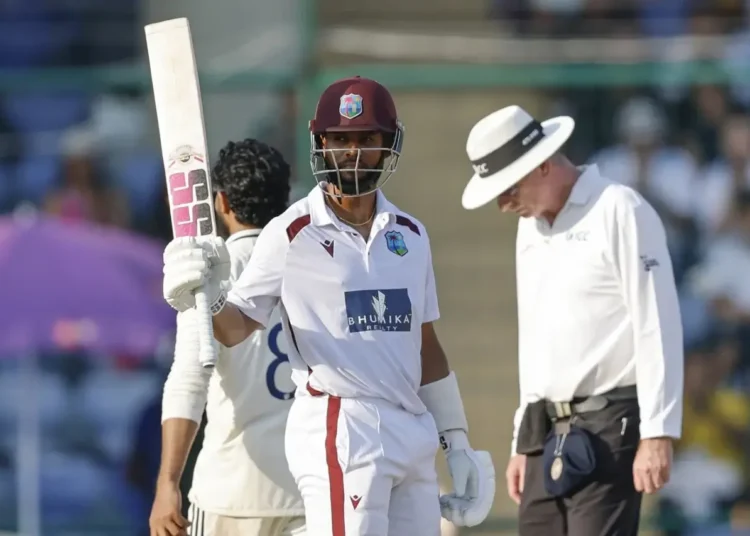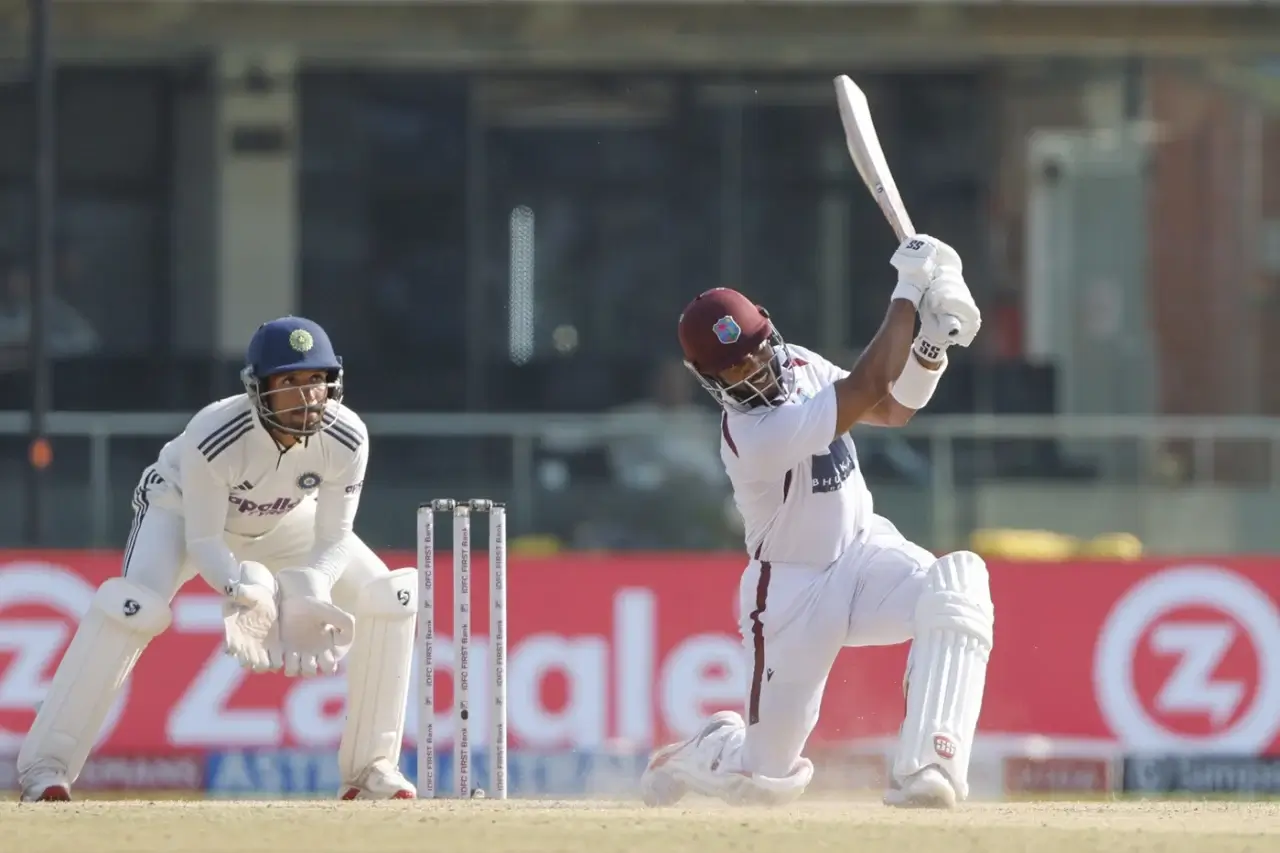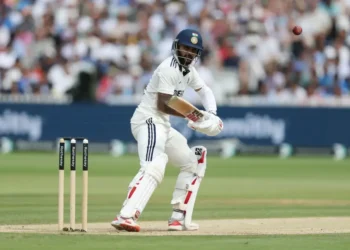India forced the follow-on in Delhi expecting quick wickets and a crumbling pitch. The decision looked bold when Kuldeep Yadav’s five-for gave India a 270-run lead. But as the day ended, West Indies turned the script around with grit and patience. Campbell and Hope batted brilliantly to keep their team alive.
The hosts bowled for long spells, looking weary as overs piled up. By stumps, India had bowled 130.5 cumulative overs in the heat. The ball softened, the wicket slowed, and West Indies finally found rhythm. Their unbroken 138-run partnership left India with more questions than answers.
Ryan ten Doeschate later admitted the plan was based on expected deterioration. Instead, the pitch only became slower, reducing help for spinners and pace alike. With India’s lead cut to 97 and the bowlers visibly fatigued, the match shifted from dominance to delicate balance in the timeline.
India’s Decision to Enforce the Follow-on: Brave or Premature?
When India dismissed West Indies for 248, enforcing the follow-on seemed logical. They had momentum, a huge lead, and spinners in rhythm. Kuldeep Yadav’s variations and control brought five wickets on a sluggish pitch. The thinking was simple — finish the game early before conditions flatten further.
But cricket rarely follows prediction. By the third evening, the Delhi pitch remained tame. The bounce stayed low but predictable, offering little bite to bowlers. Instead of a sharp turn, it only slowed, making edges die before reaching close-in fielders. India’s spinners found themselves firing the ball in faster, losing turn in the process.
Ravindra Jadeja, Kuldeep, and Washington Sundar combined for 1 for 149 in 38 overs. That statistic told the story of fading effectiveness. Bumrah and Siraj rotated in short spells to preserve energy but lacked breakthroughs. India’s fielding also slipped — misfields, overthrows, even a no-ball for fielding errors.
Ryan ten Doeschate admitted post-play that conditions hadn’t behaved as expected. The team thought the wicket would deteriorate by stumps, making chasing impossible. Instead, West Indies batted comfortably through the final session, leaving India frustrated and tired.
Campbell and Hope Shine with Discipline and Intent
Shai Hope and John Campbell began cautiously but grew in confidence with time. They left balls outside off, punished anything loose, and rotated strike beautifully. Hope mixed patience with controlled aggression, sweeping and cutting with clean timing. Campbell was bolder, taking on Kuldeep early and never letting him settle.
Hope reached his first Test fifty in 31 innings, visibly relieved and focused. Campbell brought up his half-century with a flick through midwicket, his best innings this year. Their partnership, worth 138 at stumps, was the highest of West Indies’ series. India’s attack looked flat, short of both pace and energy.
Campbell even swept Kuldeep for six and lofted Jadeja over mid-on. Hope used deft touches and late cuts to rotate strike smartly. With fatigue creeping in, India’s intensity dropped noticeably. What was meant to be a routine wrap-up became a grind under the fading lights.
The Cost of Fatigue: India’s Bowling Energy Wanes
By the end of day three, India’s bowlers had bowled 130 overs. The heavy workload began showing — slower run-ups, tired body language, reduced control. The follow-on gamble meant no rest and no recovery time. It also forced the spinners to keep attacking without much assistance from the pitch.
Jasprit Bumrah and Mohammed Siraj shared the new ball but were underused later. India tried to balance energy with wicket-taking pressure, but the mix didn’t work. The spin trio struggled for rhythm, unable to generate consistent turn or bounce. Fielding too lost sharpness, with dropped half-chances and lazy movements in the ring.
Ryan ten Doeschate said they had discussed batting again but opted otherwise. “We thought the wicket would deteriorate,” he explained, “but it slowed instead.” That small miscalculation proved costly. India’s effort to push for an early result now risked fatigue heading into day four.
The decision reminded everyone that enforcing the follow-on isn’t just tactical. It’s also physical — especially on slow Indian pitches where wickets come through hard work.
Tactical Lessons: Why Follow-ons Can Backfire in Modern Tests
In modern cricket, enforcing a follow-on carries both risk and reward. It looks dominant when it works, but draining when it doesn’t. India’s call showed confidence but also underestimated the pitch’s longevity. On low-bounce surfaces, bowlers rely on sharp turn and reverse swing. Without either, effort yields diminishing returns.
West Indies capitalized by batting patiently and cutting down risks. Their last two first-innings wickets had already shown that batting wasn’t impossible. That hint turned into proof when Campbell and Hope settled in for the long haul. Their compact defense frustrated the spinners and forced errors.
India’s reliance on spinners backfired when drift replaced spin and the ball refused to grip. Even Washington Sundar, who bowled with decent control, couldn’t break through. Once the West Indies pair survived the new ball, the rest of the day felt theirs.
Ten Doeschate’s words — “the wicket didn’t play as we thought” — summed it up best. For all of India’s planning, the pitch beat them more than the opposition did.
What Lies Ahead: India Still Leads, but Windies Eye Redemption?
Heading into day four, West Indies trail by just 97 runs with eight wickets left. Campbell and Hope will resume with confidence after their near-flawless partnership. India, meanwhile, must regroup fast, find energy, and rethink field settings. A morning wicket could swing momentum, but fatigue remains their biggest foe.
If West Indies manage to take a lead, the match could turn sharply. They’ve already shown resolve unseen earlier in the series. For India, the challenge now is mental — staying patient on a lifeless pitch. Bumrah and Kuldeep will have to strike early to regain control.
The follow-on call will be debated depending on the match outcome. For now, it stands as a reminder of Test cricket’s fine margins. Teams must weigh rest, rhythm, and realism before making bold decisions. Delhi’s pitch may still have something left, but India’s bowlers must dig deep to find it.
Conclusion
India’s follow-on gamble was brave, but fatigue turned it into a fight. Kuldeep’s five-for created the opening, yet the pitch stayed lifeless by evening. Campbell and Hope’s determined batting gave West Indies their best day of the tour. Their partnership ensured that India’s dominance met a firm challenge.
The Delhi Test still tilts India’s way, but pressure has shifted slightly. Bowlers will need sharp planning and fresh legs to regain control. Mistakes like misfields and no-balls can no longer be afforded. What seemed a quick finish now feels like a full contest again.
As the final days approach, the question lingers: did India act too soon? Maybe. Or maybe this is the fight Test cricket needed to stay alive. Either way, the follow-on call made sure — as Khary Pierre said — “the Test match is still on.”

















